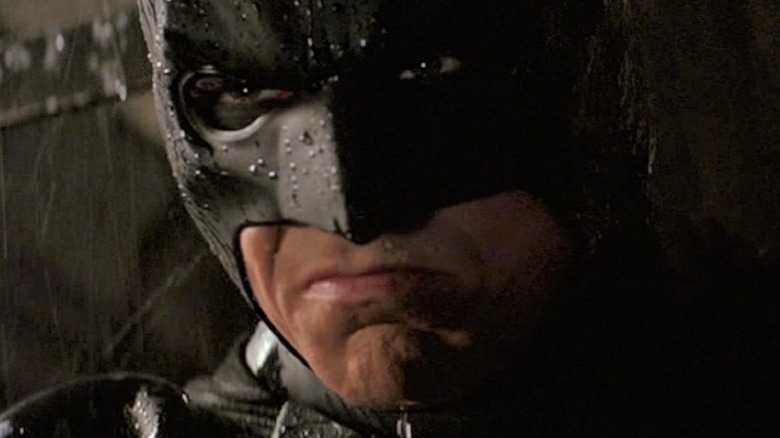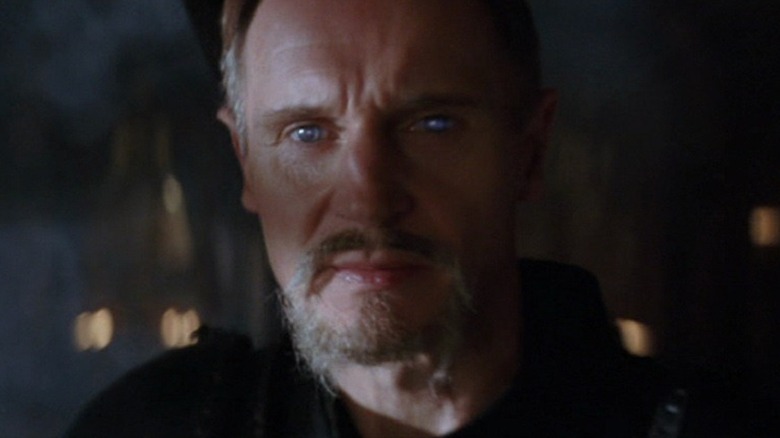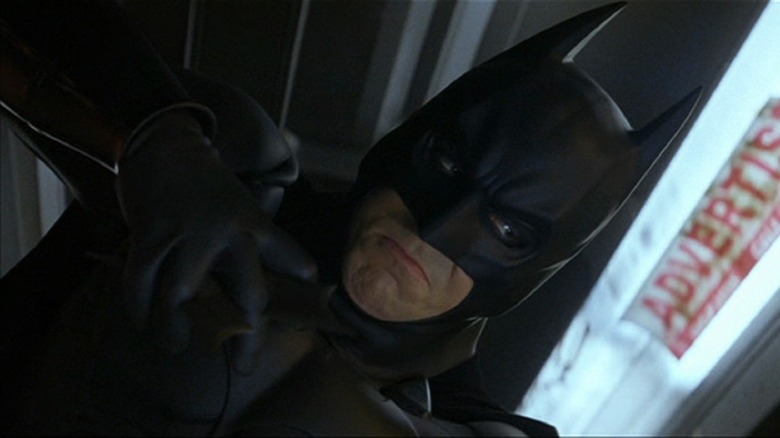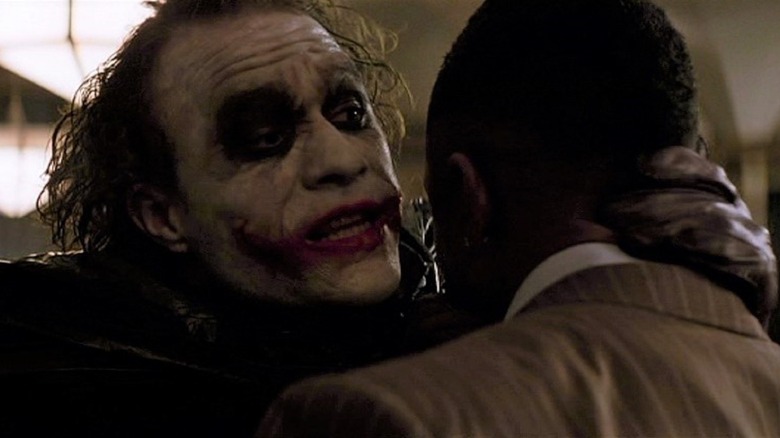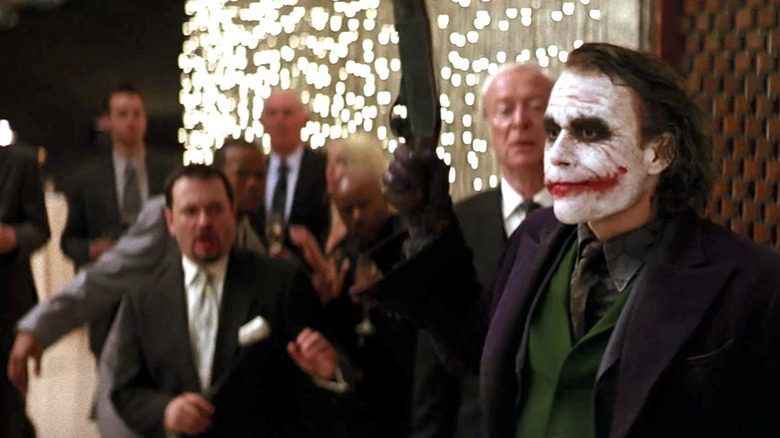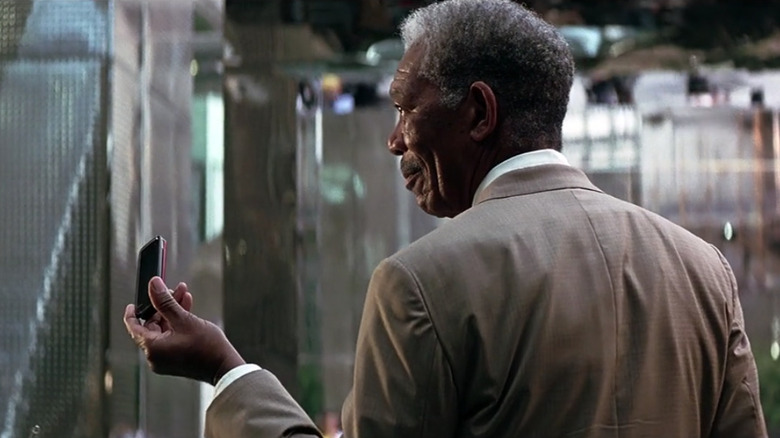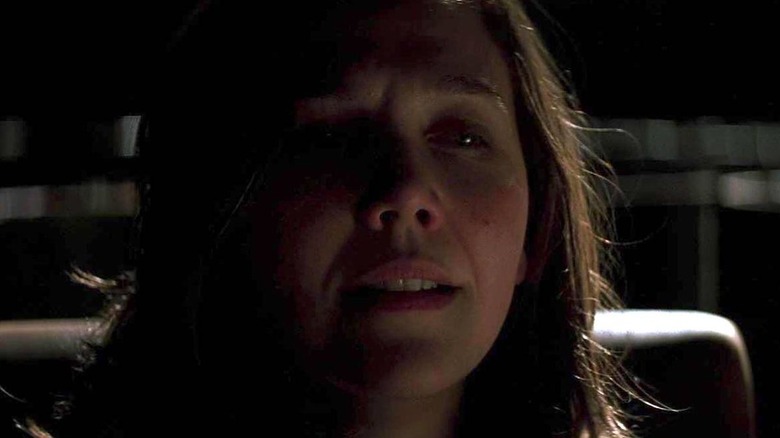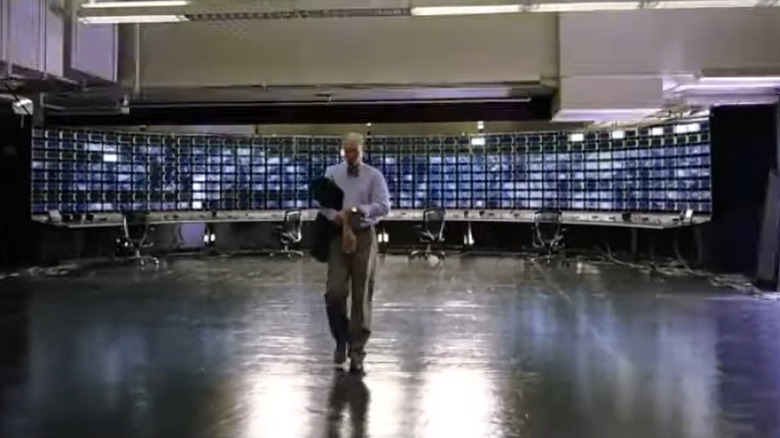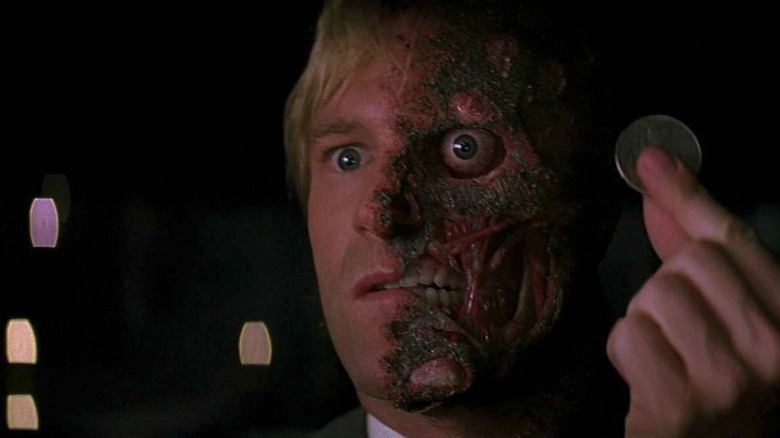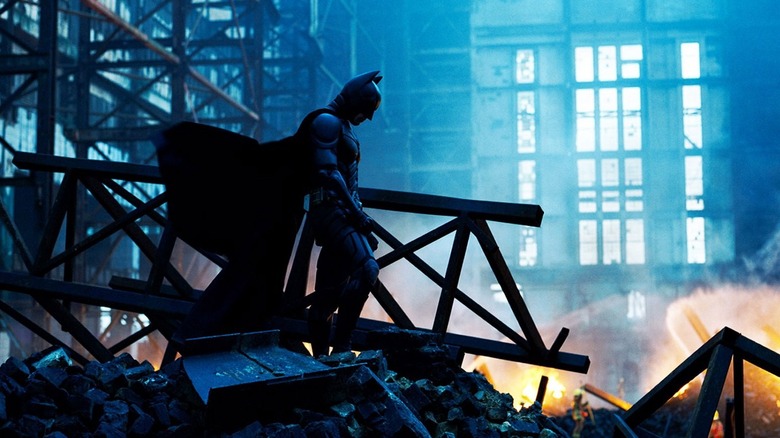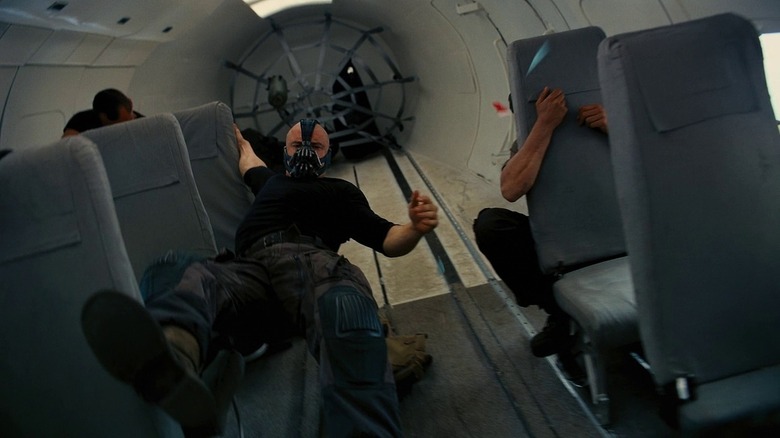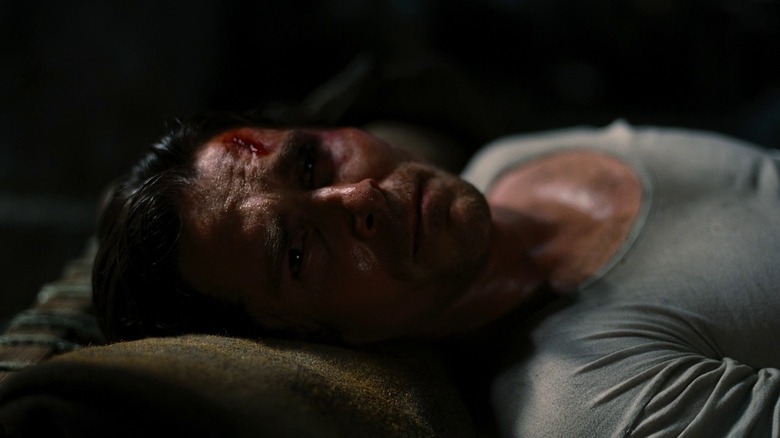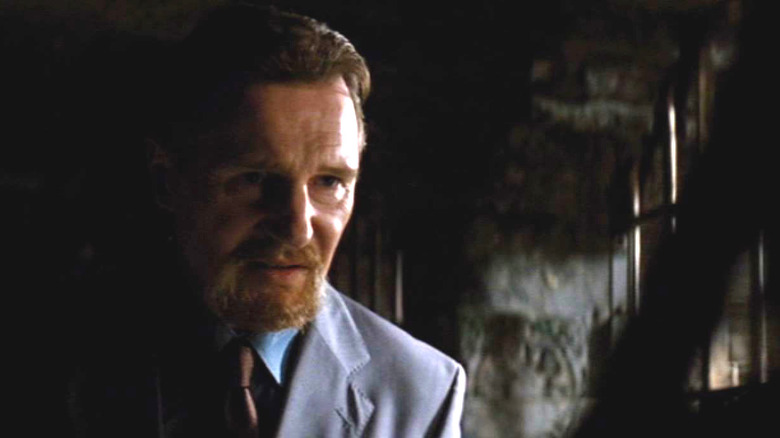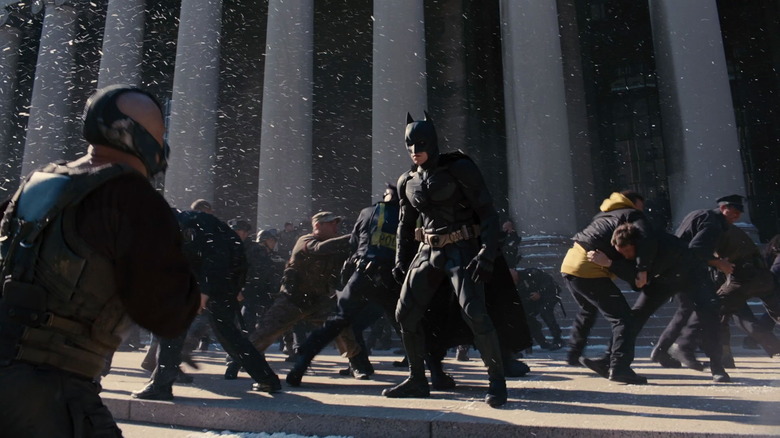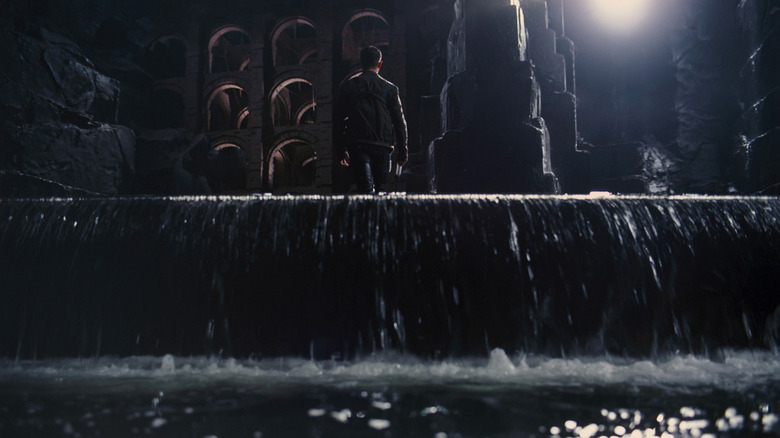Confusing Moments In The Dark Knight Trilogy Explained
In the early 2000s, DC Comics was still licking its wounds from the negative reception to the last "Batman" movie — one starring George Clooney in a nippled Batsuit. But Warner Bros., which owned the film rights to the character, couldn't move on from their most popular superhero, and they set about looking for a new directorial voice to inject fresh energy into the Caped Crusader's flagging franchise.
That director turned out to be then-smalltime filmmaker Christopher Nolan. A fan of Batman since childhood, Nolan had a very definite idea bout where he wanted to go with the character. This resulted in a trilogy of movies — "Batman Begins," "The Dark Knight," and "The Dark Knight Rises" — that changed the superhero genre forever and is counted among the greatest film trilogies of all time.
However, similar to Nolan's headier films (a la "Inception" and "Tenet"), his superhero films aren't completely straightforward. There are plenty of twists and turns — quite a few that have left audiences scratching their heads over the years. So if you need help figuring these films out, there's no need to turn on the Bat-signal. We're here to save the day and explain the most confusing moments from "The Dark Knight" trilogy. (Warning: Spoilers ahead.)
Was Ra's al Ghul really Henri Ducard all along?
At the start of "Batman Begins," a lost and bitter Bruce Wayne (Christian Bale) meets the enigmatic Henri Ducard (Liam Neeson). Ducard trains Bruce to channel his anger into becoming a master ninja warrior. Later, Ducard reveals to Bruce that he works for a man called Ra's al Ghul, who heads a powerful shadow organization with a warped view of justice called the League of Shadows.
Bruce is brought before Ra's al Ghul (Ken Watanabe) to swear allegiance to the League. But when he realizes that means he'd have to execute criminals, Bruce refuses and heads back to Gotham. After some time, Ducard reappears — only now, he's going by a different name ... Ra's al Ghul. So what's the deal here? Is Ducard the new Ra's, or was that his true identity all along?
Well, Neeson's character reveals that, much like Bruce uses a second identity as Batman, he also has dual identities as both Ducard and Ra's. With this reveal, the story circles back to Ducard's earlier words to Bruce about the importance of "theatricality and deception" in their line of business. Seriously, the guy went so far as to have Watanabe's imposter stand in for him earlier in the film. Talk about a showman. Interestingly, at a meta-textual level, the Ducard alter ego is a nod to Batman comics, where Henri Ducard was a corrupt detective who trained Bruce in his early years before the two had a falling out after the latter discovered Ducard's criminal ways.
Why did Batman let Ra's al Ghul fall to his death?
While "Batman Begins" is an action movie, the core of the film delves into the emotional baggage of the main character. Orphaned at a young age at the hands of a mugger, Bruce Wayne grew up with a deep sense of hatred towards criminals, which led him around the world, seeking to learn how to fight crime on his own terms.
Bruce found his answer after training under Ducard and the League of Shadows. But lines were drawn when the League wanted Bruce to become a killer of criminals. He refused, stating that his job was not to act as an "executioner." Bruce stuck to his principles, only doing lethal damage in self-defense, like blowing up the League's headquarters after its members tried to kill him. And at the end of the "The Dark Knight," Bruce saves the Joker from certain death by preventing his fall from a building.
But fans have wondered why Bruce didn't do the same for Ra's al Ghul at the end of "Batman Begins," when the latter fell to his death trapped inside a train in Batman's presence. An important point of contrast between the two situations was that Batman had personally thrown Joker off the building, and so he felt compelled to save the demented clown in accordance with his no-kill rule. But Ra's al Ghul's grim fate was due to his own actions, and so Batman felt no compunction about letting the villain fall.
Which Joker backstory was the real one?
Heath Ledger's performance as the Joker in "The Dark Knight" is one for the ages. Every word that escapes from the lips of the demented clown feels like a masterclass in acting by someone at the peak of his career. Ledger's iconic performance was enabled by a smart script that knew how to make the character fresh yet familiar.
A big difference between Ledger's Joker and those who'd come before was that his too-wide smile was not the result of a chemical reaction but actual scars at the corners of his lips. Over the course of the movie, Joker gives two conflicting accounts for how he got the scars, and he was about to give a third one before Batman threw him off a building. Fans have often speculated about which of the two stories was the Joker's true origin. But they forget that the character went to great lengths to hide any hint about his past.
Even the police, when they capture the Joker, were unable to find any clue as to his former identity on his person or on their records. Since Joker was obsessed with being seen as the nameless face of utter chaos, it's unlikely that he would've provided his true backstory to his victims. Instead, it's very likely that, since he knew how uncomfortable his scars made others, he told grotesque but false backstories for their presence on his face as part of his intimidation tactics.
Why leave the Joker alone with the party guests?
In the middle of "The Dark Knight," the Joker invades a party for Harvey Dent's election campaign thrown by Bruce Wayne at his penthouse. The mad clown quickly gathers the guests and starts interrogating them about Dent's whereabouts. Just as Joker starts harassing Rachel Dawes (Maggie Gyllenhaal), Batman shows up to take him on.
The fight is over quickly as Joker's henchmen are no match for the Caped Crusader. As a last-ditch effort, Joker throws Rachel out of the penthouse window to fall to her death. Acting quickly, Batman launches himself out of the window after Rachel, and he manages to catch her just in time to save her life. The scene ends there, leaving fans wondering what happened to the party guests presumably still being threatened by Joker.
The missing parts of the scene are filled in by the novelization of the movie. In the book, it's revealed that as Batman and Rachel stand on the road outside Bruce's penthouse after being tossed out of the window, they see a black SUV speeding away from them. The SUV is implied to be the Joker's getaway car, meaning the villain and his henchmen abandoned the party upstairs around the same time as Batman leapt out of the window.
What made Lucius leave his cellphone with Lau?
An important addition to Christopher Nolan's take on "Batman" was the introduction of Morgan Freeman as Lucius Fox, the man who runs Wayne Enterprises and keeps Bruce Wayne supplied with extensive crime-fighting gear. Lucius acts as the "man behind the curtain" most of the time, but occasionally, he takes a more direct approach to helping Batman fight crime.
In "The Dark Knight," Bruce reveals to Lucius that he'd deliberately sought out a business partnership with Chinese magnate Lau (Chin Han) because he knew the latter acted as a money launderer for Gotham's mob bosses. After Lau's operation is blown, he escapes to China, and Bruce sets about figuring out a way to get Lau back to Gotham without creating an international scene. To that end, Lucius visits Lau at his headquarters overseas. But before stepping inside Lau's cell phone-free building, he hands his device to a security guard and then purposefully leaves it behind when he eventually exits the lobby.
So what was Lucius trying to pull? Well, his phone had been modified to act as a sonar device. With the help of the cellphone, Batman was able to create a live-location tracking map of Lau's building, including the room where Lau was sitting and the movement of the security forces around him. This information was crucial to Batman's plan of breaking into Lau's office at night through the window, grabbing him, and escaping within minutes before any Chinese authorities could be alerted.
Why did Batman go after Harvey instead of Rachel?
While Bruce was driven to fight crime due to his anguish over the loss of his father and mother, there was one other person who meant just as much to him as his late parents — his childhood friend Rachel Dawes. The two fell out of touch after Bruce left Gotham to travel around the world and train to become a ninja, but they reconnected after Bruce came back to Gotham.
Rachel was one of the few people who knew Bruce was Batman. The two fell deeply in love, despite both knowing they could never be in a relationship due to Bruce's devotion to fighting crime as the Dark Knight. Unfortunately, the Joker realized the importance of Rachel to Batman, and he arranged to have both Rachel and Harvey Dent (Aaron Eckhart) kidnapped and kept in two separate locations. The Joker then told Batman where both Rachel and Harvey were tied up, taunting him with the fact that there was only enough time to save one of them.
Batman told Commissioner Gordon (Gary Oldman) that he was going to save Rachel, which prompted the police office to go to the second location to rescue Harvey. But then Batman turned up to save Harvey, while the police arrived too late to save Rachel. So how did Bruce arrive in the wrong location? Sadly, this was because the Joker had deliberately switched the addresses he told Batman as a further attempt to mess with the Caped Crusader at such a fraught moment.
Why was Lucius happy to see the giant Batcomputer destroyed?
Despite his "gritty" approach, Christopher Nolan incorporated many elements from the comics and cartoons in his interpretation of the Dark Knight. One such element is the giant Batcomputer, which the Caped Crusaders uses to find out all sorts of things about the criminal underworld to aid his crime-fighting.
A version of the Batcomputer pops up in "The Dark Knight." It's revealed that Bruce Wayne has been secretly using the sonar technology developed by Lucius to create a giant network of computer screens. With this massive device, he can monitor every cell phone in Gotham to spy on the city's entire population. Lucius is horrified by the invasion of privacy the giant Batcomputer involves, and he vows to leave Wayne Enterprises as long as Bruce insists on using the machine.
After using the machine to find the Joker, Bruce tells Lucius to type his name into the computer. When he does so, the Batcomputer starts self-destructing in accordance with a program Bruce had created. This makes Lucius smile because the moment proves to him that not only does Bruce know him well enough to understand Lucius wouldn't approve of the machine but also that Bruce knows where to toe the line when it comes to using his vast resources to fight crime.
Why did Batman take the blame for Harvey Dent?
The most pivotal moment of "The Dark Knight" comes at the very end. The Joker has been captured ... but not before he completely warps the psyche of Harvey Dent, turning the righteous district attorney into the supervillain Two-Face and filling him with hatred towards everyone even slightly connected to Rachel's death.
And Commissioner James Gordon is on that list, as Harvey doesn't think he acted quickly enough to rescue Rachel. In retaliation, Two-Face kidnaps Gordon's son and wife and tries to shoot them. Batman intervenes in time to stop Two-Face, but the latter dies at the end of the struggle. With the police nearing the scene of the crime, Batman tells Gordon to place the blame for Dent's various actions on his head.
This was necessitated by the fact that the whole of Gotham looked up to Harvey Dent as the most incorruptible man in the city. If news of Harvey's descent into becoming Two-Face got out, the citizens of Gotham would lose all hope in their city and its officials. To keep Harvey's name clean posthumously so he could act as a symbol of hope and inspiration, Batman allowed himself to become the scapegoat.
Why did Alfred burn the letter Rachel wrote for Bruce?
Harvey Dent wasn't just a symbol of hope for Gotham — he was a symbol of hope for Batman as well. Initially, Bruce was a bit jealous of Harvey due to the fact that he was dating Rachel. But over time, Bruce grew to accept that Harvey was a genuinely good and principled man who had the best interests of the city at heart.
In fact, Bruce was so impressed that he began to wonder if Harvey's brand of justice using the criminal law system was better for the city than Batman's vigilante actions. For the first time, Bruce began to dream of letting Harvey take over the fight for justice, hanging up his cape and cowl and finally proposing marriage to Rachel. Unfortunately what Bruce had failed to account for was that Rachel had fallen in love with Harvey. Consequently, she wrote a letter she gave to Alfred the butler (Michael Caine), in which she explained to Bruce that she intended to marry Harvey.
However, this is where things get interesting, setting up a story arc that wouldn't finish until the third film in the trilogy. After Rachel's death, Alfred burns her letter to Bruce. But what motivates the butler to go all pyro? Well, Alfred destroys the letter to spare Bruce the pain of learning the woman he loved had rejected him. After all, Alfred believes Bruce has already suffered enough pain from the loss of the loved ones in his life.
Why did Bane draw the blood of Doctor Pavel?
At the start of "The Dark Knight Rises," Bane allows himself and some of his men to be captured by the authorities so they can board a CIA plane that's transporting renegade nuclear scientist Dr. Leonid Pavel (Alon Aboutboul). Bane needs to make sure Pavel hasn't divulged any information about his people to the agency, and he also plans on forcing Pavel to work for him, turning a nuclear reactor core into a city-wide bomb.
This leads to one of the best action scenes in the franchise, as Bane's goons hijack the plane. Before making his grand escape, Bane kills the CIA agents and abducts Pavel ... and that's when things get weird. Bane forcibly takes some of Pavel's blood, transferring it into the body of a dead guy that Bane's henchman brought along. If you're wondering why, the idea here is that when the CIA investigates the plane wreckage, they'll find a body with Pavel's blood and conclude the scientist died due to the crash. It's a pretty sneaky plan, one that shows Bane packs both brains and brawn.
How did Bruce fix his back?
When we first see Bruce Wayne in "The Dark Knight Rises," he's retired from his duties as Batman. He's also grown older and is suffering from a leg injury that necessitates the use of a walking stick. But despite being out of shape, Bruce has no choice but to get back under the cowl after he becomes aware of the threat posed by Bane.
Feeling that Gotham needs him again, Bruce straps on a leg brace and goes after his new foe. Unfortunately the hulking terrorist proves too young and strong. In fact, their epic first battle ends with Bane breaking Bruce's back. After that, Bruce is carted away to a distant prison. There, as he watches Bane unleash terror on Gotham, Batman works on fixing his injury with the help of a prison doctor. Of course, we know the Caped Crusader will heal and return for round two ... but how? Well, as it turns out, Bruce is suffering from a herniated disc in his spine, and the doctor forces the disc back in place through a forceful punch.
Then after days of being on his back, Bruce's spine is made stronger by holding most of his weight upright using a hanging rope harness, which lets him practice walking and moving around again. Eventually, Bruce regains his strength well enough to escape the prison. Of course, the method of recovery shown in the movie has very little basis in reality. The biggest artistic license the movie took was showing a herniated disc being fixed via punching, which in reality would only serve to damage the spinal cord even further.
Did Ra's al Ghul make a comeback?
In the comics, Ra's al Ghul is an immortal character who's lived for many centuries with the help of the life-giving "Lazarus Pits." Christopher Nolan's movies were too grounded to allow for the inclusion of the Pits, but the director found another way to pay homage to the idea of Ra's being an immortal adversary by having Liam Neeson make a short cameo in "The Dark Knight Rises."
While Bruce is lying in prison with his broken back, he sees a vision of Ra's coming to greet him. The apparition looks pretty solid, leading Bruce to wonder if the real Ra's has returned from the dead. The two speak for a bit, during which Ra's tells Bruce about how Bane was a small child who'd been born in that prison and had eventually escaped by climbing up the walls without a safety harness.
Some fans have wondered if Ra's was only a figment of Bruce's imagination, how was he able to reveal any information to Bruce? But you have to remember that information turned out to be false since, in reality, it wasn't Bane who escaped the prison but Talia (Marion Cotillard). This proves Ra's appearance was a part of Bruce's fevered dreams, as his mind grappled with the bits and pieces of information that he'd learned from the prison doctor and arrived at the wrong conclusion.
How was Batman able to suddenly defeat Bane?
There's no easy way to say this. Batman gets his butt handed to him by Bane the first time the two meet. The battle can't even be classified as a real fight since Bane is clearly in charge the whole time, toying with Batman to the extent that his henchmen don't even feel the need to jump in for an assist.
The "fight" ends pretty decisively when Bane breaks Batman's back bare-handed and leaves the Dark Knight groaning in pain on the floor. Cut to about five months later, and Batman returns to Gotham after having healed his back and having done some pushups while trapped in prison. This time when Bane fights Batman, he gets handily defeated by the Caped Crusader, which doesn't make much sense given his earlier dominance. But the truth is Batman had learned from his earlier mistakes.
Like Bane said, Batman had previously fought "with nothing held back," tiring himself out quickly and allowing Bane to get the upper hand. During their second fight, Batman stayed defensive and fought tactically. He'd also learned from the prison doctor that Bane's face mask kept the latter from feeling intense, persistent pain. So Batman knocked one of the pipes in the mask loose to drive Bane mad with agony. In his enraged state, Bane expended his strength and energy demolishing a concrete pillar. This gave Batman the opportunity to go all-in on the temporarily exhausted Bane with a flurry of punches and kicks that finally brought the monster down.
What happens to John Blake?
"The Dark Knight Rises" wasn't just a farewell party for Bruce Wayne but also a welcome part for Gotham's next Dark Knight. At the start of the movie, we meet Officer John Blake (Joseph Gordon-Levitt), who proves his detective chops by revealing he'd already figured out that Bruce Wayne was Batman due to their shared experience with childhood trauma.
Over the rest of the story, we see Blake become James Gordon's right-hand man and a useful ally of Batman in their battle to take back control of Gotham from Bane. Again and again, Blake proves himself to be smart, courageous, and highly principled. And in the end, it's revealed that Blake's childhood name was "Robin" and that Bruce Wayne has given him the keys (figuratively speaking) to the Batcave and all his crime-fighting gadgets.
Naturally, the "Robin" name is a reference to Batman's famous sidekick from the comics. The movie ends with Blake rising up on to the Batcave's main platform, which, considering the title of the film, is a pretty clear indication that Blake will be taking over as the new Batman watching over Gotham city now that Bruce has retired so he could go hang out at a café, waiting to surprise Alfred.
